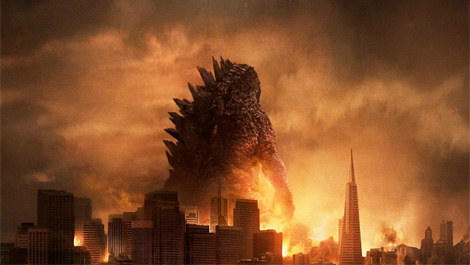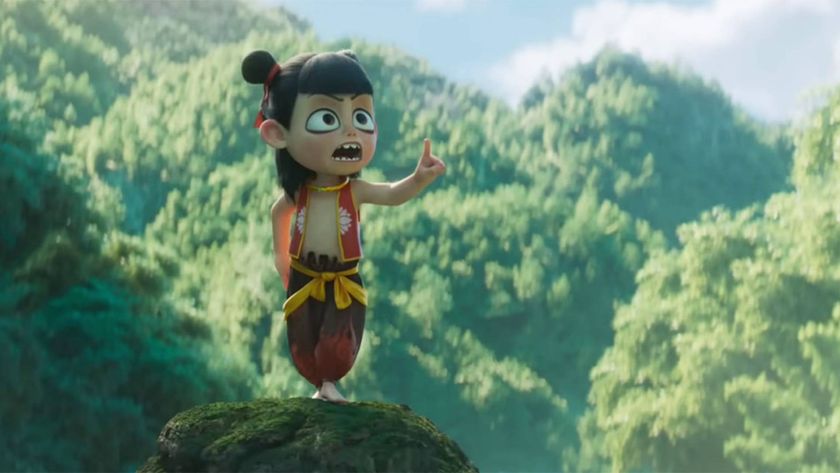Why you can trust GamesRadar+
Subtlety and restraint aren’t words you tend to associate with tentpole blockbusters, particularly not those featuring hulking great monsters. The latest incarnation of Toho’s iconic kaiju might be the tallest ever, clocking in at around 350ft, but the movie itself isn’t afraid to build to the stomping with baby-steps, favouring tension over excessive VFX money shots, and the human characters over the headline creature.
Director Gareth Edwards won the director’s chair off the back of Monsters , his micro-budgeted creature feature that, by necessity, put human characters at the front of the drama, leaving the titular beasties mostly just hinted at through incredibly subtle background CGI. It’s heartening that, given this film’s reported $150m-plus budget, he’s stayed true to that movie’s central tenets even when playing with a much bigger train set. Perhaps Godzilla 2014’s greatest achievement is that it doesn’t feel like it has been churned out on a Hollywood production line. Refusing to adhere rigidly to the prescribed beats of the blockbuster formula, it often feels surprisingly low-key for a film in which major cities are levelled and destruction spans continents.
It helps that, of all the franchises, being repeatedly torn down and rebuilt, Godzilla is arguably the one that could actually do with a reboot. Roland Emmerich’s calamitous attempt is now 16 years old, negating the too-soon syndrome afflicting Spider-Man . Godz has always been a good vehicle for expressing wider societal concerns – born, as he was, back in 1954, to riff on fears of nuclear weaponry – and given the modern taste for reality-grounded franchise fare, it’s a rare case of a welcome, even necessary, revival.
With Edwards zooming in on the human reaction to the carnage, it makes sense that there’s one family at the heart of the story. A 1999-set prologue sees nuclear physicist Joe Brody (Bryan Cranston) unearthing a vast skeleton in the Philippines, before bearing witness to the collapse of the Japanese powerplant where he works. Fifteen years later, his young son Ford (Aaron Taylor-Johnson) has moved on, returning to his family after a tour with the US Navy, while Brody Sr. continues to obsess over the incident. It’s against this dynamic of separated families that the bigger story, of prehistoric monsters rampaging through the modern world, plays out.
At times it can feel like the high-calibre cast are adding layers to a sparse script, particularly when it comes to Breaking Bad ’s Cranston, who delivers some searing emotional moments during the film’s opening scenes. The female roles are given particularly short shrift: Elizabeth Olsen has disappointingly little to do, while Sally Hawkins is mostly left to reel off jittery scientist exposition. Taylor-Johnson – carrying convincing military bulk – does a solid job with a fairly straightforward character: Edwards’ commitment to believability means that there are no gung-ho heroes, and no hissable bad guys. It’s a case of humans versus a force of nature.
Like Spielberg’s most thrilling films, Jaws and Jurassic Park (where the creatures’ appearances were kept down by visual effects limitations), here you’re made to wait a fair while until you get a glimpse of the title star. There’s even one set-piece, which cuts away to a TV news report as the action kicks in, which might have you wishing Edwards hadn’t been quite so judicious with his reveals.
What this approach does reap though, is a genuine sense of tension and, crucially, payoff, that’s so rare in films of this scale. When the beast is finally unleashed, the set-pieces are worth savouring. Early glimpses reveal little more than Godzilla’s jagged, shard-like spines protruding out from the sea, while the rest of him’s submerged underwater like an armoured iceberg. Even in the limited moments when he’s seen in his full glory – thick snout, chunky forearms, scales like armour carved from rock – he’s pleasingly, untameably animalistic. ( Monsters fans will appreciated some of the subtle, unsentimental interactions).
To give too much detail on the film’s most impressive set-pieces would be to spoil their impact (despite the recent glut of trailers and clips doing just that). Given Edwards’ POV-heavy visual instincts (much is glimpsed through visors, car windscreens, news reports), Godzilla – despite having his name on the poster – almost feels like a supporting character. While that in itself might leave audiences raised on a cinema diet of instant gratification feeling unsatisfied and yearning for just a little more destruction, when the climactic moments do come, they’re felt on a much more appreciable scale than, say, the casual cityscape-flattening in Man Of Steel . The globe-hopping feels grounded, and justified, and you’re actually invested in the chaos and monster smackdowns. For that reason, Godzilla feels like a noble endeavour, and one that deserves to be savoured on its own terms.
Verdict:
That rare breed of blockbuster that emphasises character over spectacle and slow-burn tension over relentless action sequences, Godzilla rewards patience with strong performances and sparing, spine-tingling set-pieces.




I'm the Editor at Total Film magazine, overseeing the running of the mag, and generally obsessing over all things Nolan, Kubrick and Pixar. Over the past decade I've worked in various roles for TF online and in print, including at GamesRadar+, and you can often hear me nattering on the Inside Total Film podcast. Bucket-list-ticking career highlights have included reporting from the set of Tenet and Avengers: Infinity War, as well as covering Comic-Con, TIFF and the Sundance Film Festival.













